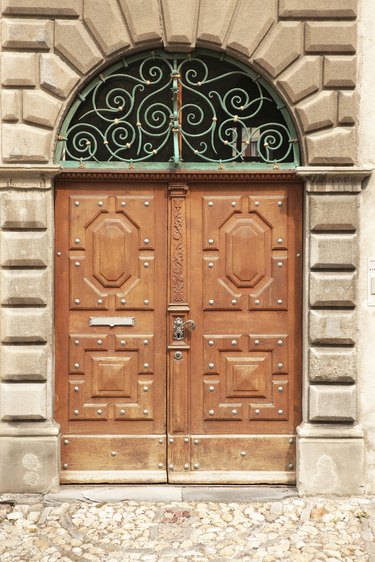
Homeowners often wish to show the beauty of quality wood on exterior doors and trim with a clear finish. This can cause problems if you apply the wrong type of polyurethane. The finish will not hold up to the sun and weather, requiring yet another refinish job. Polyurethane can be used successfully outdoors if it has the proper ingredients. Look for a finish that has additives for ultraviolet protection. The label should say for exterior use so the dried finish will flex with the expanding and contracting wood.
Polyurethane
Video of the Day
Because polyurethane is a clear finish, it can bring out the beauty of wood. A popular choice for cabinets and trim, it also protects wood. Exterior polyurethane contains polyurethane resin, a flatting agent that reduces the gloss, ultraviolet absorber and solvent. Most polyurethanes rated for exterior use will be oil based. Don't attempt to use an interior polyurethane outside because the finish will peel off very quickly.
Video of the Day
Ultraviolet Resistance
Clear finishes don't have the durability of paint. The clear finish that allows the wood grain to show through also lets damaging sunlight through. Ultraviolet blocking can get tricky. Most formulations use finely ground metallic compounds that are transparent to visible light but reflect ultraviolet light. Titanium dioxide often gets used for this purpose. Ultraviolet absorbing compounds absorb the rays and release it as heat. Neither additive is 100 percent effective. To block ultraviolet light more effectively, you need more blocking compounds. But adding more would make it opaque like paint.
Flexibility
Wood expands and contracts with humidity, wind and temperature. Exterior polyurethanes must have the right combination of oils and resins so the finish will flex with the wood. Even with special additives, Minwax recommends recoating once a year. If recoated while the old finish is still in good condition, you only need to remove grease and dirt, sand and wipe down with mineral spirits to prepare the surface.
Considerations
While exterior polyurethane is available in both oil and latex versions, Coastal Contractor finds that the water-based versions just don't hold up as well as the oil versions. The amount of UV protectant contained in the polyurethane affects durability. Manufacturers guard this information, so you don't know if it is a generous amount or just a drop or two. For best results, stick with a good brand and pay attention to the coverage and number of coats information on the label. The recommended coverage takes into consideration the right amount of ultraviolet protectant for the wood. Stir the polyurethane before and during application to evenly distribute the ultraviolet-blocking ingredients.